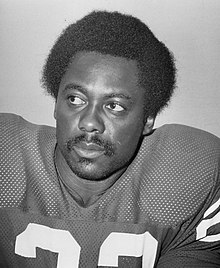Cyril Calvin Pinder (November 13, 1946 – January 22, 2021)[1] was an American professional football player who was a running back in the National Football League (NFL) for the Philadelphia Eagles, Chicago Bears, and Dallas Cowboys. He played college football for the Illinois Fighting Illini.
 Pinder, circa 1971 | |||
| No. 22, 33 | |||
|---|---|---|---|
| Position: | Running back | ||
| Personal information | |||
| Born: | November 13, 1946 Fort Lauderdale, Florida, U.S. | ||
| Died: | January 22, 2021 (aged 74) | ||
| Height: | 6 ft 2 in (1.88 m) | ||
| Weight: | 210 lb (95 kg) | ||
| Career information | |||
| High school: | Crispus Attucks (Hollywood, Florida) | ||
| College: | Illinois | ||
| NFL draft: | 1968 / Round: 2 / Pick: 39 | ||
| Career history | |||
| Career NFL statistics | |||
| |||
| Player stats at NFL.com · PFR | |||
Early years edit
Pinder attended Crispus Attucks High School in Hollywood, Florida, where he began playing football as a junior. He was an All-state selection at both football and basketball. He also practiced track.
He accepted a scholarship from the University of Illinois. During his junior year with the Fighting Illini, he was declared permanently ineligible by the Big Ten Conference on March 4, 1967, for having more than US $500 in expenses per year paid for by money from a slush fund set up by the university's athletic department.[2] He finished his college career with 92 carries for 434 yards and 5 touchdowns. He also was an indoor sprint champion.
Professional career edit
Philadelphia Eagles edit
Pinder was selected by the Philadelphia Eagles in the second round (39th overall) of the 1968 NFL draft, to replace running back Timmy Brown.[3] In 1970, he became the team leading rusher with 166 carries for 657 and 2 touchdowns. On September 13, 1971, after having a difficult contract negotiation,[4] he was traded to the Chicago Bears in exchange for a 1972 second round (#37-Dan Yochum) and a 1973 fourth round selection (#83-Gery Palmer).[5]
Chicago Bears edit
In 1971, he was acquired by the Chicago Bears for depth purposes while Gale Sayers was recovering from his career-threatening right knee injury. He was cut on September 10, 1973.[6]
Dallas Cowboys edit
On September 28, 1973, he was signed by the Dallas Cowboys to replace running back Bill Thomas.[7] He spent his time between the active roster and the taxi squad, before being cut at the end of the 1973 season.
Chicago Fire (WFL) edit
In June, 1974, he was signed by the Chicago Fire of the World Football League.[8] He was named the team's starter at running back and registered 925 rushing yards and 8 touchdowns.
Chicago Winds (WFL) edit
In 1975, the Chicago Winds replaced the Fire in the World Football League. Pinder was signed on June 24, though the new team was evicted from the league after just five games.
Personal life edit
After football, he worked as an investment banker for ten years. He also worked for WLS-TV in Chicago. Pinder died on January 22, 2021, at the age of 74. He is one of at least 345 NFL players to be diagnosed after death with chronic traumatic encephalopathy (CTE), which is caused by repeated hits to the head.[9][10]
References edit
- ^ Likas, Mark (January 24, 2021). "Pinder, former Illini and Bears running back, dies at 74". The News-Gazette. Retrieved February 19, 2016.
- ^ "Illinois Athletes Ruled Ineligible," The Associated Press, Sunday, March 5, 1967. Retrieved January 14, 2012.
- ^ "Kuharich wants better defense for Philadelphia team in 1968". Rome News-Tribune. AP. 7 August 1968. p. 15. Retrieved 25 March 2010.
- ^ "Cyril Finder Says He Is Unhappy". Retrieved February 19, 2016.
- ^ "Karras Released By Lions; Vikings, Bears Are Busy". Retrieved February 19, 2016.[permanent dead link]
- ^ "Pro Football Moves". Retrieved February 19, 2016.
- ^ "Football". Retrieved February 19, 2016.
- ^ "Pinder In Camp Of Chicago Fire". Retrieved February 19, 2016.
- ^ "The driving force behind Chronic Traumatic Encephalopathy (CTE)". Concussion Legacy Foundation. Retrieved July 2, 2023.
- ^ Ken Belson and Benjamin Mueller (June 20, 2023). "Collective Force of Head Hits, Not Just the Number of Them, Increases Odds of C.T.E. The largest study of chronic traumatic encephalopathy to date found that the cumulative force of head hits absorbed by players in their careers is the best predictor of future brain disease". The New York Times. Retrieved July 2, 2023.